Table of Contents
Accelerated by technological advances and global events like COVID-19, the paradigm of teamwork is evolving, with hybrid, remote, and distributed teams becoming the new norm. When executed successfully, workplace collaboration has the power to significantly enhance seamless teamwork along with project efficiency, productivity, and output quality. However, navigating the complexities of collaboration comes with its own set of challenges.
In this comprehensive guide, we’ll explore how collaboration can drive success while also addressing some of the key challenges that teams may encounter along the way. We’ll also delve into the pros and cons of collaboration in the workplace and analyze them in their entirety.
Alongside our analysis, we’ll introduce you to an innovative tool designed to elevate efficiency and quality for collaborative content teams. So, get ready to unlock the full potential of your team’s collaboration efforts as we embark on this insightful journey together.
Pros and Cons of Workplace Collaboration: A Deep Dive
In navigating the complexities of workplace collaboration, it’s essential to recognize both its benefits and challenges. By leveraging the strengths of collaboration while addressing its pitfalls, teams can harness the full potential of collaborative efforts, driving innovation, productivity, and success.
Let’s explore some of the key aspects of collaboration in the workplace:
Pro: Improved Quality
Collaboration often leads to enhanced quality in work outputs. Peer review cycles, for example, facilitate constructive feedback and refinement, resulting in higher-quality content in collaborative projects. By leveraging diverse perspectives and expertise, teams can identify and address potential flaws or areas for improvement, ultimately delivering superior results. This not only ensures that the final product meets or exceeds expectations but also enhances the reputation of the team or organization for delivering top-notch work.
Con: Extensive Feedback Loops
While collaboration can enhance quality, it can also introduce challenges such as extensive feedback loops. Multiple stakeholders providing input can prolong review cycles, delaying time-to-market and impeding progress. This delay can be frustrating for team members and stakeholders alike, especially in fast-paced industries where agility is key. Centralized communication and the use of collaboration tools are essential in mitigating this challenge, ensuring efficient feedback processes and timely decision-making. Moreover, establishing clear guidelines for feedback and setting realistic deadlines can help streamline the review process without sacrificing quality.
Pro: Effective Division of Labor
One of the strengths of collaboration lies in its ability to facilitate the effective division of labor. By assigning roles and responsibilities based on individual strengths and expertise, teams can optimize productivity and engagement. Clear alignment between tasks and team members ensures that resources are utilized efficiently, leading to streamlined workflows and accelerated project timelines. This allows team members to focus on what they do best, maximizing their contributions to the project while minimizing redundancy and overlap.
Con: Ambiguous Roles and Responsibilities
However, ambiguous roles and responsibilities can hinder collaborative efforts. Without clear leadership and defined roles, productivity may suffer as tasks are duplicated or overlooked. This can lead to confusion and frustration among team members, ultimately impacting project outcomes. Establishing clear communication channels and assigning specific responsibilities at the project’s outset are crucial steps in maximizing efficiency and productivity. Additionally, regular check-ins and updates can help ensure that everyone knows their role and contributes effectively to the team’s objectives, reducing the likelihood of misunderstandings or miscommunications.
Pro: Increased Creativity
Collaboration fosters creativity by encouraging the sharing and development of ideas among team members. By working together, individuals can inspire and challenge each other, leading to innovative solutions and breakthroughs. Collaborative environments provide a platform for brainstorming, experimentation, and exploration, nurturing a culture of creativity and innovation. This not only enhances the quality of the final product but also boosts morale and satisfaction among team members, fostering a dynamic and stimulating work environment.
Con: Collaborative Inertia
However, collaboration can also lead to inertia when an excess of ideas and opinions impedes decision-making and progress. Striking a balance between brainstorming and decision-making is essential to prevent projects from stalling. Effective communication and strong leadership play vital roles in guiding discussions, prioritizing ideas, and maintaining momentum. By establishing clear objectives and timelines, teams can ensure that creative energy is channeled towards achieving tangible results, rather than getting bogged down in endless debates or deliberations.
Pro: Better Knowledge Sharing
Collaboration facilitates knowledge sharing between different disciplines, fostering cross-pollination of ideas and best practices. By leveraging diverse expertise, teams can capitalize on collective insights and experiences, driving overall productivity and effectiveness. Collaborative environments encourage continuous learning and growth, empowering individuals to expand their skill sets and contribute to shared goals. This not only benefits the team or organization in the short term but also cultivates a culture of innovation and adaptability that positions them for long-term success in a rapidly evolving marketplace.
Con: Organizational Silos
Despite its benefits, collaboration can lead to organizational silos when communication and resource-sharing are inadequate. Interdisciplinary teams must actively communicate and collaborate to avoid silos and bottlenecks that hinder project efficiency. Centralized communication channels and transparent workflows are essential in breaking down silos, fostering cross-functional collaboration, and ensuring seamless project execution. By promoting a culture of openness and collaboration, organizations can tear down the barriers that separate departments or teams, enabling them to work together towards common goals and objectives.
Pro: Shared Accountability and Decision-Making
Effective collaboration cultivates shared accountability among team members, fostering a sense of ownership and commitment to project outcomes. Collaborative decision-making processes encourage participation and input from all stakeholders, leading to well-informed decisions and collective buy-in. Mutual trust and respect strengthen team cohesion and morale, driving success and achievement of shared objectives. This shared accountability not only enhances team dynamics but also promotes a culture of responsibility and transparency that underpins organizational success.
Con: Lack of Accountability and Trust
However, challenges arise when accountability and trust are lacking within collaborative teams. Shared responsibility can lead to diffusion of accountability, with team members shifting blame or avoiding ownership of tasks. Consistent communication, clear goal-setting, and strong leadership are essential in fostering accountability and trust. By establishing clear expectations and holding team members accountable for their actions, leaders can ensure that everyone is aligned and committed to achieving common goals. Moreover, cultivating a culture of trust and transparency can help build stronger relationships among team members, fostering collaboration and cooperation across the organization.
Maximizing Productivity with Collaborative Management Tools
When it comes to collaborative work, success hinges not only on best practices but also on having the right tools at your disposal. Multicollab is a transformative plugin which has been designed to streamline collaboration in content projects within WordPress so that content teams can overcome collaboration challenges.
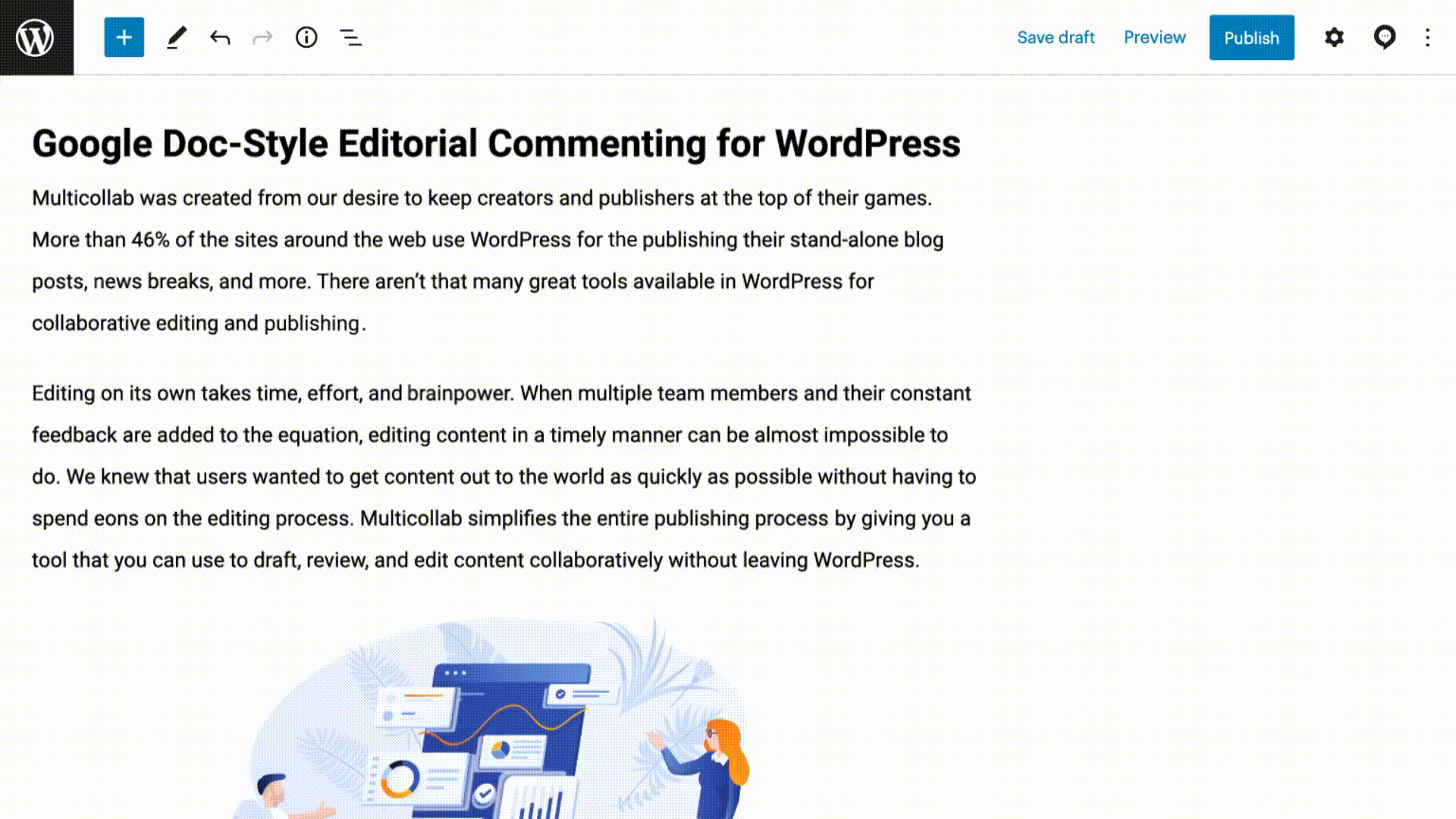
Key features of Multicollab include:
Real-time Editing and Commenting within WordPress: Multicollab facilitates seamless collaboration by enabling real-time editing and commenting directly within WordPress. Users can collaborate with multiple users simultaneously and edit content together in real-time. Hence, content teams can work more efficiently, make instant changes, and witness content come to life collaboratively – right in the WordPress interface. This centralized communication improves efficiency, shortens feedback loops, and eliminates organizational silos and bottlenecks, ensuring swift progress and cohesive teamwork.
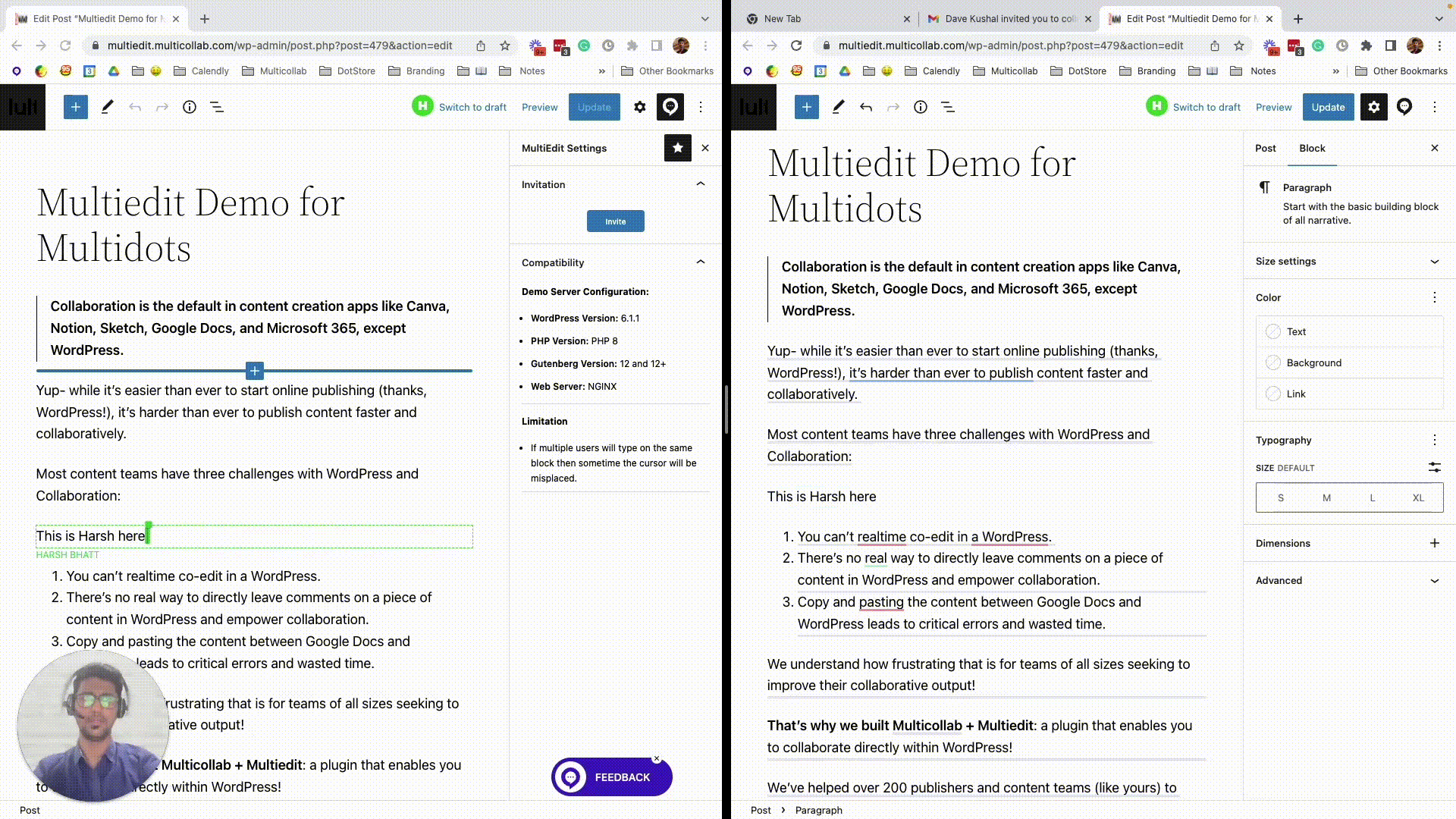
Automatic Slack and Email Notifications: With enabled email notifications, teams can quickly review and easily click notifications to respond directly in WordPress. Team members receive instant alerts when tasks are assigned to them, enhancing accountability and clarity in roles and responsibilities. No more ambiguity, everyone knows their role and can act promptly to keep projects moving forward.
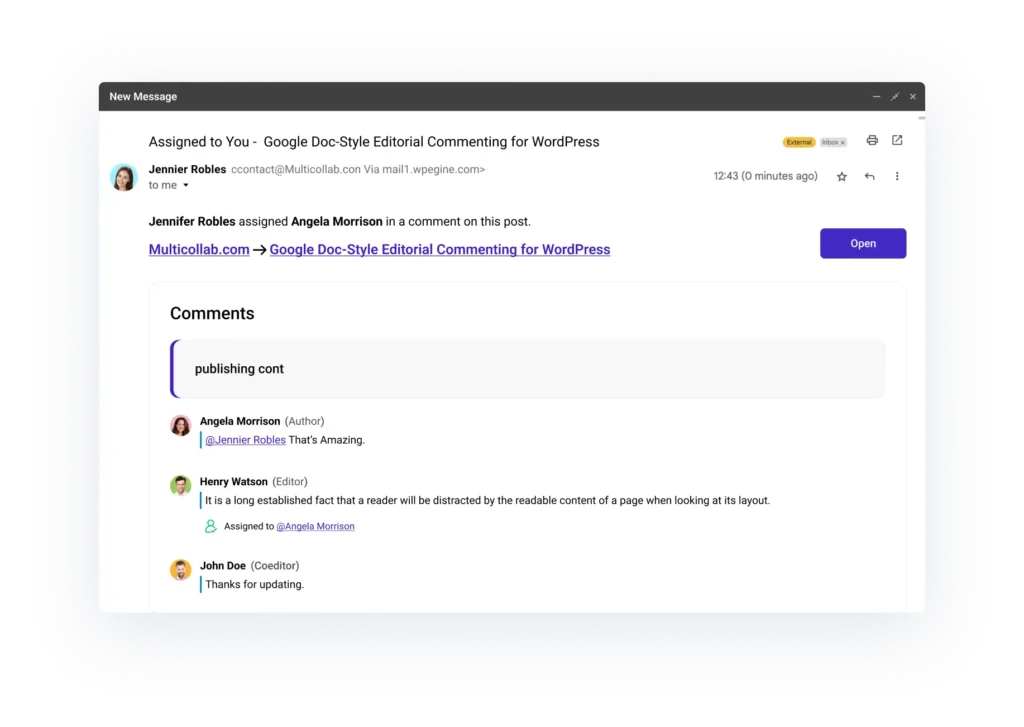
Activity Timelines and Snapshot Reporting: Gain insights into project progress with Multicollab’s activity timelines and snapshot reporting. With the Advanced Dashboard functionality, teams can get better insight into their editorial workflow with transparent data points and an intuitive reporting feature.
The Activity Timeline monitors collaboration and tracks progress across all pages and posts with easy filtering to view by user, content categories, and time stamps. Teams can discover what they need with Quick Snapshot Reporting for the latest comment activities on each page and post. These features provide a quick overview of project status and next actions, preventing collaborative inertia and ensuring clarity on project direction.
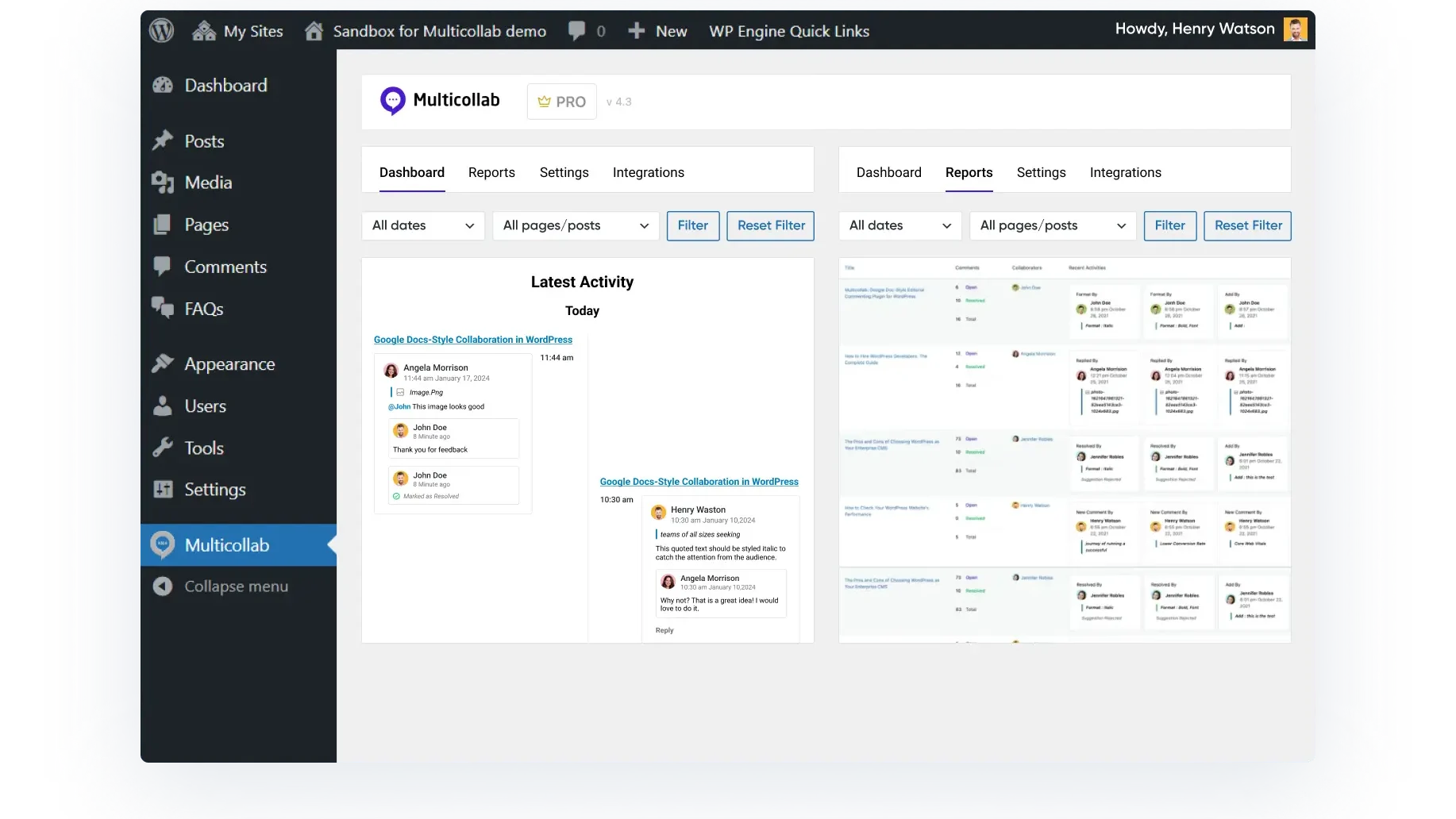
Easy Permissions Management for Collaborators: Multicollab simplifies permissions management, allowing you to assign specific access permissions to chosen team members. This ensures that only relevant individuals are involved at each stage of the project, increasing efficiency and avoiding unnecessary collaboration. For example, teams can easily decide which team members should have permission to manage comments and suggestions in Multicollab. They can configure who should have access to add a comment, resolve comments, and disable comments and who should have access to accept or reject suggestions.
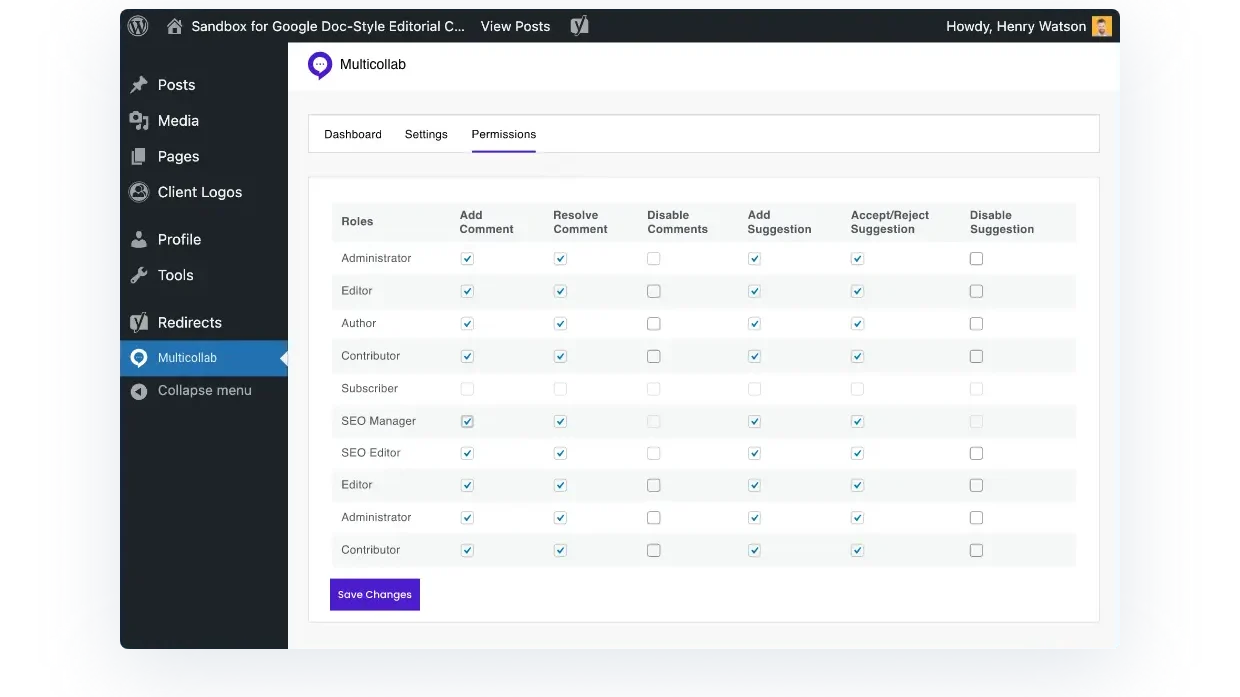
With Multicollab, teams can overcome collaboration challenges and maximize productivity, leading to smoother workflows, faster project completion, and superior outcomes. Say goodbye to collaboration roadblocks and hello to seamless teamwork with Multicollab.
Multicollab: Your Next Step in Transforming Workplace Collaboration
Embracing effective collaboration is non-negotiable for businesses striving to thrive in today’s fast-paced world. When managed well, collaboration can lead teams towards great efficiency, productivity, and output quality. However, it’s essential to acknowledge that collaboration isn’t without its obstacles. Success lies in effectively navigating these challenges, which requires a combination of best practices and the right tools.
Multicollab is a game-changer for workplace collaboration. With its intuitive features and seamless integration, the plugin empowers teams to overcome collaboration hurdles and unlock their full potential. From streamlined communication to enhanced project management, it revolutionizes the way teams work together.
So, why wait? Take the next step in transforming your workplace collaboration by getting started with Multicollab today!







